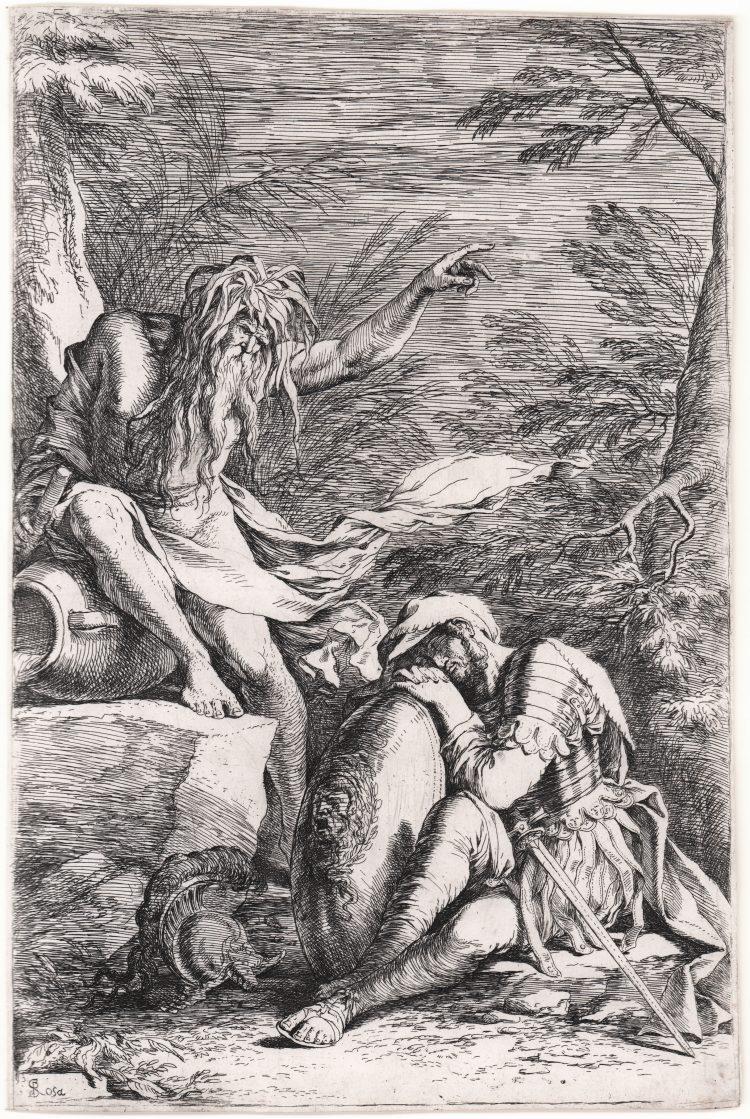




| Reference: | S42685 |
| Author | Salvator ROSA |
| Year: | 1663 ca. |
| Measures: | 232 x 350 mm |



| Reference: | S42685 |
| Author | Salvator ROSA |
| Year: | 1663 ca. |
| Measures: | 232 x 350 mm |
Etching, circa 1663-64, signed in plate at lower left.
Magnificent proof, rich in tone, printed on contemporary laid paper with watermark "Easter lamb in the double circle" (Heawood no. 2838, Rome 1647), trimmed to copperplate, in excellent condition.
"The subject of this engraving is taken from a passage of Virgil's Aeneid (canto VIII, vv. 26-34) and narrates the dream that Aeneas had on the bank of the Tiber, when, tired of the preparations of the war against the Latins, he had in a dream the vision of the god Tiberinus who urged him to ask Evander for help. Salvator Rosa elaborated various drawings of the two figures placed in the foreground, while he executed, as was usual, the landscape of the background directly on the plate. Ideally connected to the engraving with Jason and the dragon, the Dream of Aeneas has been dated by Rotili between the end of 1663 and the beginning of 1664 for stylistic reasons. Il Rosa then executed a pictorial version of these two prints, unlike his larger format engravings, such as the Fall of the Giants, for which he never found a client willing to finance the relative painting. The characterizing elements of this print are both the nocturnal setting, determined by a calm luminosity, which increases the sense of oneiric mystery, and the suggestions of the seventeenth-century Roman classicism, taken in particular from Castiglione and Testa, but relived with a serene emotional participation that preludes the romantic interpretation" (cfr. Stefania Massari, Tra mito e allegoria, immagini a stampa nel '500 e '600, p. 462).
Beautiful example, in a rare contemporary edition, of this masterpiece by Salvator Rosa.
On verso, collection mark of the painter and engraver Friedrick Koch (1771-1832) - Lugt 1020 – and another one not described by Lugt.
Bibliografia
Bartsch, 1820, XX, n. 23; Le Blanc, 1858, III, p. 360, n. 108, Mahoney, 1977, I, p. 641, n. 74.1-5, Wallace, 1979, p. 307, n. 117; D'Amico, 1981, cat. n. 156. 24; Rotili, 1974, pp. 234, n. e fig. 108; Massari, Tra mito e allegoria, immagini a stampa nel ‘500 e ‘600, pp. 462-463, n.178.
Salvator ROSA (Napoli 1615 - Roma 1673)
|
Like Testa, Castiglione and Della Bella, Salvator Rosa considered the art of engraving the best technique to express his talent and, it is not by chance that he is considered, together with the already mentioned artists, one of the protagonists of Italian seventeenth-century art.
Rosa was an extremely eclectic person; his main models in art were the classicism of Carracci, the naturalism of Ribera, the contemporary Roman painting and the ancient world.
From the latter in particular, Rosa drew inspiration for his engravings, whose subjects come from the old Stoic philosophy, with the glorification of virtues though allegories. We have also to consider his passion for esotericism, which inspired him with pictorial compositions with necromancy.
His technique and total command of etching enabled his prints to be appreciated even from his contemporaries, copied by them and highly requested by collectors.
|
Salvator ROSA (Napoli 1615 - Roma 1673)
|
Like Testa, Castiglione and Della Bella, Salvator Rosa considered the art of engraving the best technique to express his talent and, it is not by chance that he is considered, together with the already mentioned artists, one of the protagonists of Italian seventeenth-century art.
Rosa was an extremely eclectic person; his main models in art were the classicism of Carracci, the naturalism of Ribera, the contemporary Roman painting and the ancient world.
From the latter in particular, Rosa drew inspiration for his engravings, whose subjects come from the old Stoic philosophy, with the glorification of virtues though allegories. We have also to consider his passion for esotericism, which inspired him with pictorial compositions with necromancy.
His technique and total command of etching enabled his prints to be appreciated even from his contemporaries, copied by them and highly requested by collectors.
|